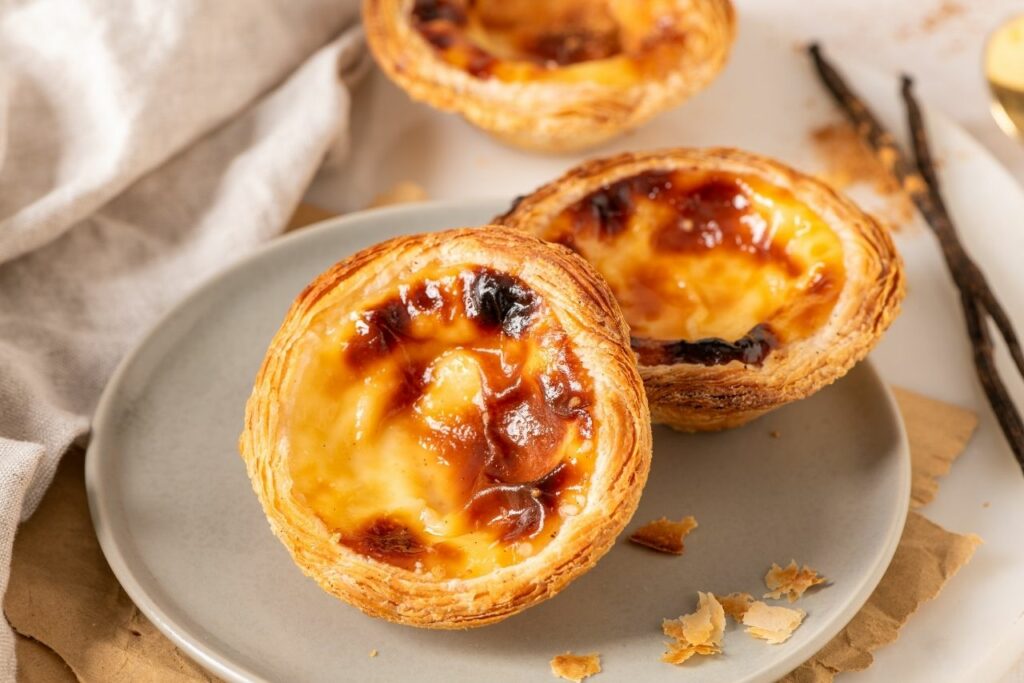Portugal’s most iconic pastry is the Pastel de Nata—an egg‑custard tart born from convent kitchens and perfected over centuries. Crisp, flaky pastry filled with silken custard that caramelizes on top… it’s a small miracle in every bite.

🍮 History & Heritage
- The recipe originated with monks at the Jerónimos Monastery in Belém, Lisbon, who used leftover egg yolks from laundry starching to create sweet pastries. This practice is part of Portugal’s tradition of doçaria conventual (monastic sweets) .
- When religious orders were dissolved in the 1830s, the recipe was sold and later became the famous “Pastéis de Belém”, sold only in that shop since 1837 .
Although Pastéis de Belém refers to the original version, pastéis de nata is the broader name for this national treasure found across Portugal and beyond .
🥣 Ingredients (makes ~12 tarts)
- Puff pastry (homemade or store‑bought)
- Egg yolks (6–8)
- Sugar (100 g)
- Water (80 ml)
- Cinnamon stick (or a pinch ground cinnamon)
- Lemon peel (optional)
- Milk (or cream) 200 ml
- Flour (or cornstarch) 15 g
- A pinch of salt
(Measured proportions adapted from common recipes including Spanish Sabores and others) .
🔪 Instructions
- Make the sugar syrup:
Combine sugar, water, cinnamon stick, and lemon peel in a saucepan. Heat without stirring until 100 °C (220 °F), then remove from heat and cool 10–15 min . - Prepare the custard:
Whisk milk, flour (or cornstarch), and salt in a separate pot. Cook over medium heat, stirring until thick (about 5 min). Remove from heat, cool slightly, then slowly whisk in egg yolks and the cooled sugar syrup, straining to avoid lumps . - Shape the pastry cups:
Roll puff pastry into a tight log (folded in layers), cut into 12 pieces, and press into muffin tins or small tart pans, forming cups with layered, flaky walls . - Fill and bake:
Fill pastry cups about ¾ full with custard. Bake in a VERY hot oven—ideally ~290 °C (550 °F), or your oven’s maximum—until the custard is blistered and browned and the pastry is golden (10–12 min) . - Serve warm:
Let cool slightly, dust with cinnamon or icing sugar if you like. Best eaten fresh and warm, ideally within hours of baking. The crispy crust is key! .
🧡 Tips for Perfection
- Use small, flat tins (~10 cm diameter, ~2 cm deep)—this helps achieve the right custard‑to‑crust ratio .
- Extreme oven heat creates the signature caramelized top and flaky shell .
- Custard flavor is delicate—cinnamon and lemon peel add subtle aromatic lift; avoid overpowering with too much sugar or spice .
✨ Final Thoughts
Biting into a Pastel de Nata is like tasting history: sweetened egg yolks from convent kitchens, cold Lisbon mornings, and centuries of care handed down through generations. It’s small, yes—but it carries a universe of texture, sweetness, and authenticity.
Whether you’re experimenting with homemade puff pastry or keeping it simple with store‑bought sheets, this ritualistic treat brings Portugal’s culinary soul into your kitchen. Serve it with a café or a glass of tawny Port and you’ll feel transported.
Bom apetite—queijos com nata e doçura.
